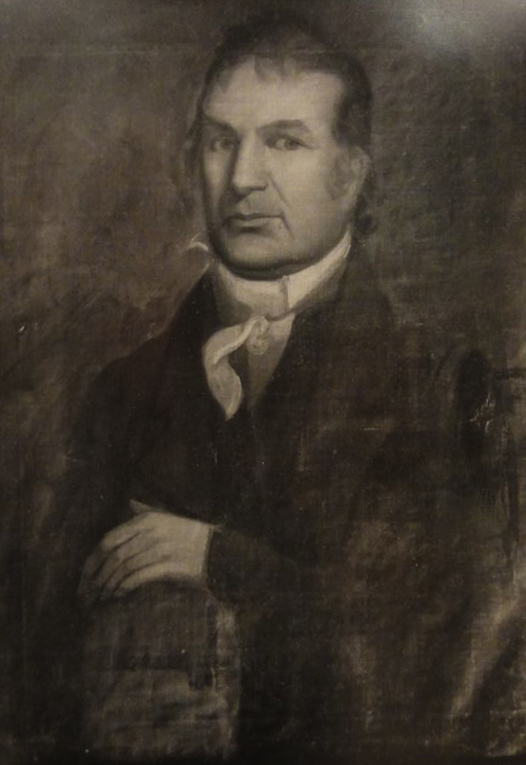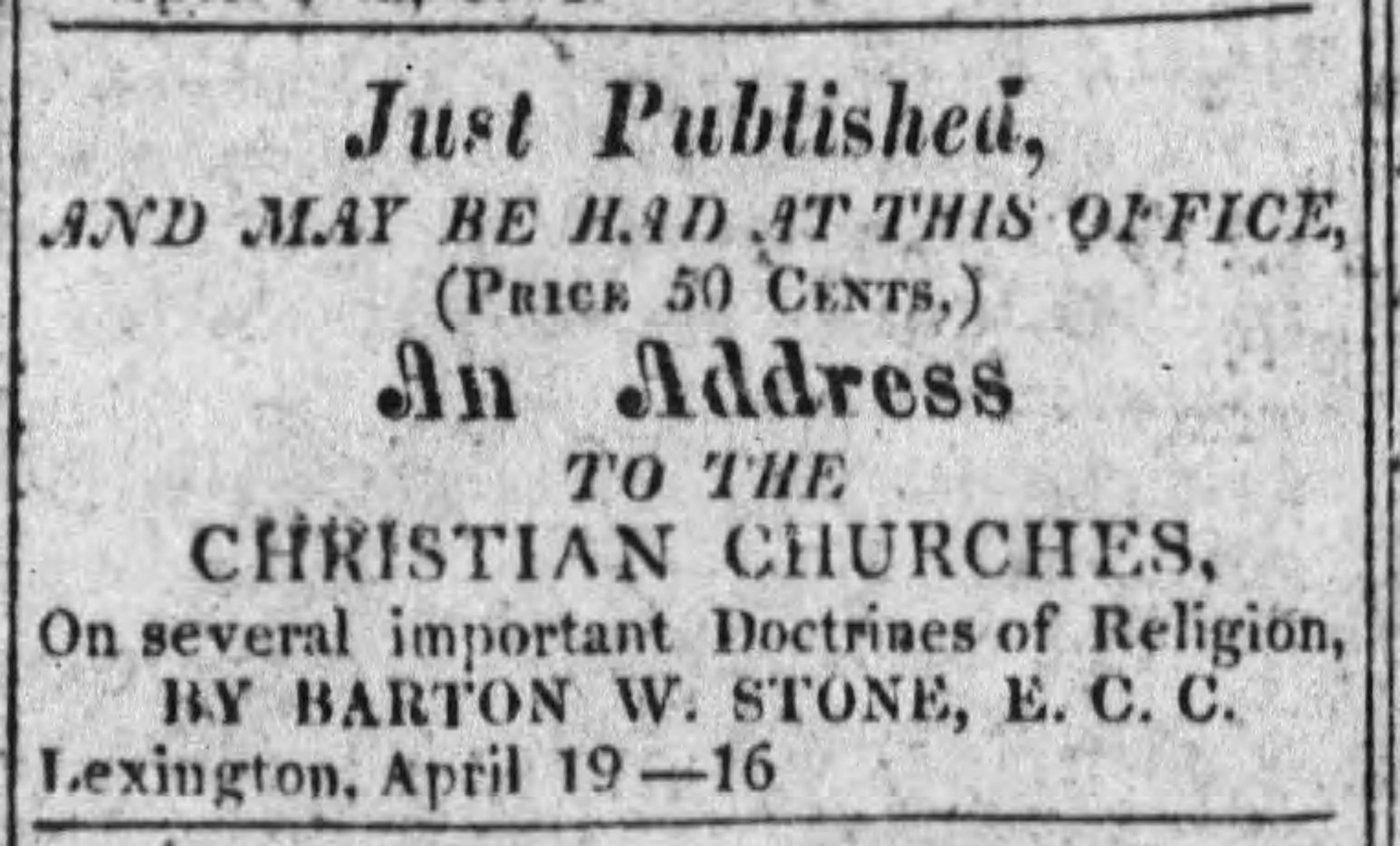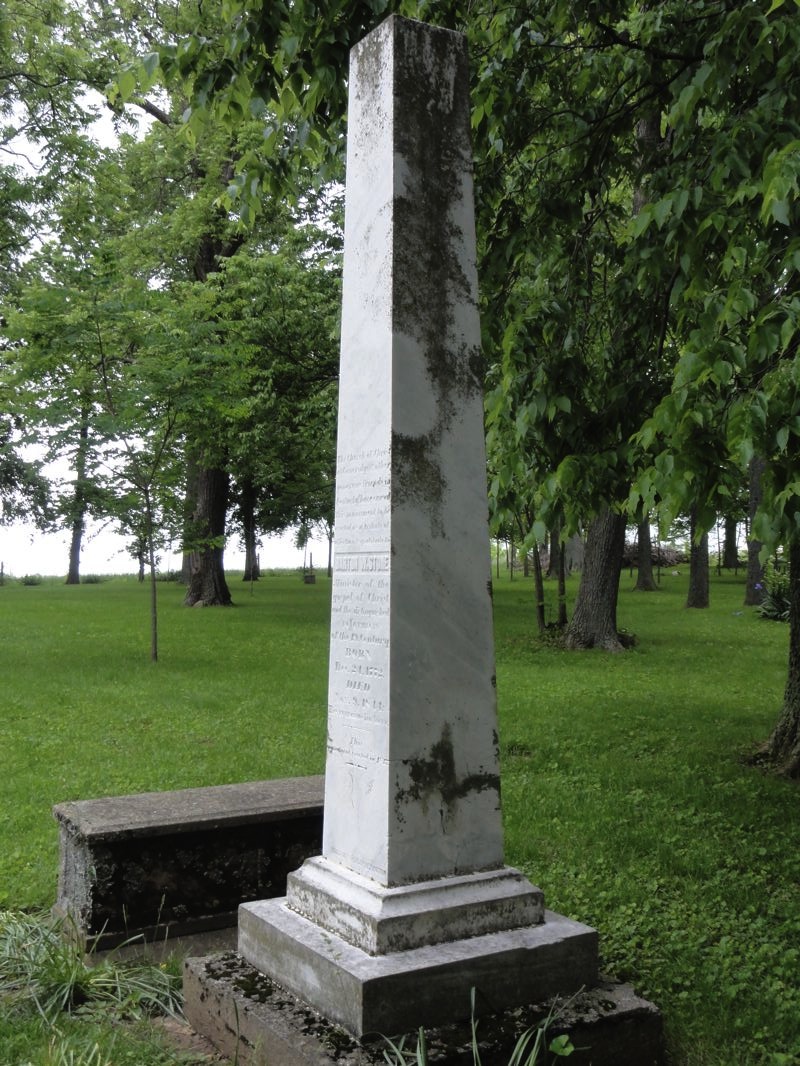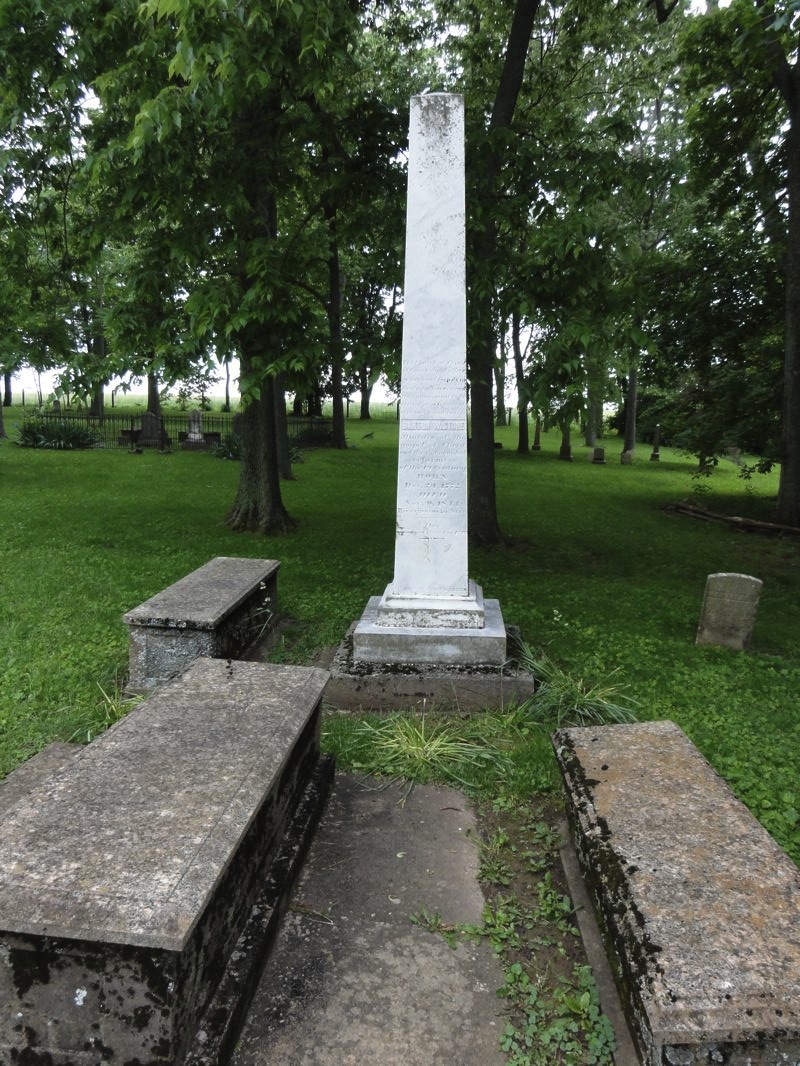Barton Warren Stone
1772-1844
![]()
Biographical Sketch On The Life Of Barton W. Stone
Barton W. Stone was born in Maryland, December 24, 1772. At the time of his birth the religious world was in a state of confusion. Chaotic conditions prevailed among the different denominations as well as in the midst of each denomination. Mr. Stone received the impressions of the prevailing religious customs early in his youth. After a peculiar religious experience, he joined the Presbyterian Church.
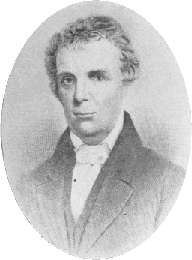
He had grave doubts about some of the points of doctrine of the Presbyterian Church. Before he joined this church he had a long conversation with two Presbyterian ministers, relating to them the state of his mind on some points which disturbed him. These ministers wished to retain so promising a young man for the Presbyterian Church. They asked him how far he would be willing to subscribe to the Confession. He replied: 'As far as it is consistent with the word of God.' This showed his great respect, even while he was in the wilderness of confusion, for the word of God. When he was ordained as a minister in the Presbyterian Church, he gave the same answer to the presbytery-that he would subscribe to the Confession only so far as it was consistent with the word of God. His answer to those who questioned him about his faith in the Confession indicated the character of the man.
Mr. Stone in appearance was grave, holy, meek, plain, and humble. He was firm in his convictions and true to the word of God as he saw it. His preaching the Bible soon brought him into trouble with the Presbyterian Church. He soon saw that the wearing of the name 'Presbyterian' encouraged a party spirit. He at once called together the churches for which he was preaching and informed them that he could no longer conscientiously preach to support the Presbyterian Church and that his efforts henceforth would be directed to the advancement of the Redeemer's kingdom. Later he said: 'I sacrificed the friendship of two large congregations and an ample salary. I preferred the truth to the friendship and kindness of my associates in the Presbyterian ministry.' After casting away the Presbyterian name and the man-made creed, he took the name 'Christian' and set forth on the mission of a child of God under that name. As a result of his close study of the New Testament and his desire to follow it, he, with five other Presbyterian ministers, published the 'Last Will and Testament of the Springfield Presbytery.' At this time he was laboring in Kentucky. The first item of this will reads as follows: 'We will that this body die, be dissolved, and sink into union with the body of Christ at large; for there is but one body and one Spirit, even as we are called in one hope of our calling.' The second item reads: 'We will that our name of distinction, with its reverend title, be forgotten, that there be but one Lord over God's heritage, and his name One.' The last item of the will reads: 'Finally, we will that all our sister bodies read their Bibles carefully, that they may see their fate there determined, and prepare for death before it is too late.' The effect of this document was great upon the Presbyterian Church. Mr. Stone did not intend to withdraw from the Presbyterian Church at that time. He thought that the whole Presbyterian Church would see that it was an unscriptural organization and that all would unite with him on the New Testament. In this he was disappointed. He soon saw that he could not remain in the Presbyterian Church and at the same time advocate the principles which he then believed. He had a higher regard for the new-found truths of the New Testament than he had for the Presbyterian Church; so he had to give it up.
The movement which he had started soon began to take on larger dimensions. Soon the greater part of Central Kentucky was influenced by this movement. His next step was to adopt faith-baptism as the only baptism; that is, he gave up infant baptism and accepted immersion only as baptism, and that for the remission of sins. He gradually came to a fuller knowledge of the truth as revealed in the Bible. He applied himself diligently to the study of the New Testament, and rejoiced in every new-found truth that he discovered therein. He was especially impressed with the simplicity of the New Testament teaching as contrasted with the theories of human creeds. Many saw the truth with him and helped him to form churches after the New Testament order. These churches multiplied rapidly throughout Kentucky and Ohio.
Mr. Stone at this time had never met Alexander Campbell. There were two movements which were independent of each other, if not wholly ignorant of each other. These two movements were led by Alexander Campbell and Barton W. Stone. They seemed to be running parallel. Mr. Campbell was laboring in Pennsylvania, Ohio, and Virginia; while Mr. Stone was laboring in Kentucky and Ohio. Both movements had practically the same purpose and work to achieve. Each was calling upon people to cast aside all human names and man-made creeds and take the Bible as the basis for Christian union, to follow it and become and be just what it directed. It is probable that the movement headed by Stone was begun a little earlier than the one begun by Mr. Campbell. As has been observed in the sketch of Alexander Campbell's life, he was affiliated with the Baptist Church; and while thus connected in a loose way with the Baptists, Stone was leading many of the Presbyterians out of denominational bondage. Mr. Campbell and Mr. Stone met for the first time at Georgetown, Ky., in 1824, and they soon became steadfast friends. Each was in full sympathy with the other. They had so much in common and so little difference that the two movements began to converge. Mr. Campbell was publishing the Christian Baptist, and Mr. Stone began publishing the Christian Messenger in 1826. These publications helped to bring together the two movements.
Those who were associated with Mr. Campbell called themselves 'Disciples of Christ,' while those who were associated with Mr. Stone called themselves 'Christians.' Their enemies called the movement led by Campbell 'Reformers' or 'Campbellites,' while the enemies called Mr. Stone and his followers 'New Lights' or 'Stoneites.' Most of those who were associated with Stone came from the Presbyterians, while most of those who were associated with Campbell came from the Baptists. In January, 1832, a meeting was convened at Lexington, Ky., with the view of uniting these two movements into a permanent union. The emphasis with Mr. Stone had been placed upon the idea of uniting all men under Christ, while Mr. Campbell had placed the emphasis on exact conformity to the primitive faith and practice. The one had the New Testament idea and spirit of unity, while the other had the idea of work and worship according to the New Testament. It was not difficult to unite these two, as both were New Testament teachings.
At the meeting in Lexington, Mr. Stone found himself fully in accord with the thought and purpose of the union and gave full and hearty endorsement to it. Both parties had been wearing Scriptural names. Both had been making the blunder of excluding all other Scriptural names. They now saw that God's people could be disciples, Christians, brethren, and heirs of God. Mr. Stone never ceased to rejoice in the success of the truth of the gospel. He loved the truth of God supremely and devoted all the energies of his life to the church of his Lord.
Barton W. Stone died at Hannibal, Mo., in November, 1844. After two previous burials, he was finally laid to rest at Cane Ridge, Ky. A marble shaft bearing this inscription marks the spot: 'The church of Christ at Cane Ridge and other generous friends in Kentucky have caused this monument to be erected as a tribute of affection and gratitude to Barton W. Stone, minister of the gospel of Christ and the distinguished reformer of the nineteenth century. Born December 24, 1772: died November 9, 1844. His remains lie here. This monument erected in 1847.'
-From Biographical Sketches Of Gospel Preachers, H. Leo Boles, Gospel Advocate Company, Nashville, Tennessee, 1932, pages 28-32
![]()
The Last Hours of Elder B.W. Stone
'When I entered the room where the dying man lay, it was well filled with his children, grand-children, relations and particular friends, who were gazing with the most interest, and the deepest anxiety, upon the face of this eminence saint. The looks, the tears, the sighs the prayers, were all characteristic of the scene, and spoke louder than words could do, the feeling of the assembly. When he heard my name pronounced, he turned his face towards me, he lifted his hands, with it his voice, and expressed his gratitude to God that he had seen me once more before he left this world, and that I had come time enough to see him before he died, and to pray and to converse with him, which privilege he had feared he should never have enjoyed. Never cane I forget the impressions which were then engraven upon my mind, which were produced by the intelligence, the calmness, the sweetness, the expressive smile of his soul, speaking and beaming through his face—which was peculiar to him—while the tears silently stole down his furrowed cheek.
'After clasping my hand fast in his hands, he commenced conversation upon his great and absorbing theme, the love of Go to man, and of his Saviour to his poor dying creatures—his exceeding great and precious promises to us in his blessed word. He quoted a large number of these from the Old and New Testaments, with the correction, for which he was remarkable, with remarks upon them, adding, my pain is great, my breath and strength are almost gone. Oh! that I had strength to preach and exhort all around me to live like christians, to adore their profession; my heart and my strength fails me. But God is the strength of my heart and my portion forever. Whom have I in Heaven but Thee, and there is none upon the earth in comparison to Thee. Thou shalt guide me with thy counsel, and afterwards receive me to glory. After reading, singing, praying and weeping awhile, he commenced again; and, as it is an opinion of great antiquity, that the nearer men approach their dissolution, the more divine their souls become, so it appeared to be in his case, while his heart and flesh were failing him, he appeared to be climbing Jacob's ladder, by faith and prayer, higher and higher, and to be struggling to reach the highest round in it. There was an inexpressible benignity and sweet calmness and devotion resting upon his countenance, with an occasional ejaculation, "O, my Saviour, I love Thee; how great is thy goodness to me!' His faith grew brighter and brighter until the sun set with all that brilliancy with which it had shone through a long life, and which is peculiar to the natural sun in the Asiatic countries. 'Mark the perfect man, behold the upright, for the end of that man is peace. As was said of Moses, he was meek above all men that were pun the face of the earth, so was he remarkable for his kindness, patience, humility and charity. Few men were more rudely buffeted than he was in his day, and no man nor it with more equanimity and fortitude than he did.'
-Christian, Messenger And Advocate (The Bible Advocate briefly merged with the Christian Messenger), St. Louis, January, 1847, Vol. 5, No. 1, page 17
Note: This is from John R. Howard's, The Bible Advocate, A brief researching led me to find "Christianos' as identified as Elder A. Broaddus in the 1833 volume of the Millennial Harbinger, page 315. The Encyclopedia of the Stone-Campbell Movement identifies "Cristianos' as a pseudonym for Archibald McKeever. p. 614. It is uncertain who Christianos was.
![]()
Newspaper Advertisement of
An Address To The Christian Churches
Kentucky Gazette, Lexington Kentucky
Thursday, April 26, 1821, page 3
A Chronology on the Life of Barton W. Stone
December 24, 1772
BWS born in Port Tobacco, Maryland — Spends the first seven years of his life there.
Summer, 1775
John Stone dies
1779
Family moves to the Dan River Valley, in the southwestern part of Pittsylvania County, Virginia
1784
Elizabeth 'Eliza' Campbell was born
September 12, 1788
BWS is 16 years old, Alexander Campbell is born in Ireland
December 24, 1789
At age 17 BWS was able to receive money from his father's estate; After the first of the year he determines to use it for becoming a lawyer.
February, 1790
Left home to attend a noted Academy in Guilford, North Carolina, under the direction of Doc. David Caldwell.' (Bio.p.6) Presbyterian minister. (Caldwell in his 56th year, a graduate of Princeton in 1761). BWS began studying Latin in view of his law degree.
February, 1791
Attended a meeting at Sandy River in Virginia with some fellow students to hear James McGready preach. Negative results.
Spring, 1791
"Got Religion' under the preaching of William Hodge, of Hawfields "New Light' Presbyterian Church
June 1, 1792
Kentucky becomes the 15th state in the United States Of America
1793
Completed Classical Course / Candidate as Presbyterian Minister, but did not accept
January, 1795
BWS becomes professor of Languages, at Hope Hull's (1763-1818) Methodist, Succoth Academy, Washington, Georgia
January 1, 1796
BWS attends a Methodist conference with Hope Hull in Charleston, S.C. Met over twenty Methodist ministers including Francis Asbury (head of American Methodist Episcopal Church)
March, 1796
Last week in month he left Washington, Ga to return to Hawfields, NC, a 321 mile journey.
April 6, 1796
Received Presbyterian Preacher license at session of Orange Presbytery. The 70 year old Henry Patillo, (1726-1801), spoke to the three licentiates Stone; Robert Foster, & Robert Tate expressing that their greatest duty was to uphold the words of Bible.
May 1, 1796
In Eastern N.C., Failure in his first preaching appointment challenged BWS to examine whether preaching was what he needed to do. His companion R. Foster also faltered.
May 15, 1796
At Grimes Meeting House on Reed Creek, BWS preaches again, this time with boldness, then determining that this was his mission in life. Ministered there until July 1st.
August 14, 1796
Leaves Knoxville for Cumberland Settlements around Nashville
Fall, 1796
BWS arrives In Lexington, Kentucky. Only two Presbyterian existed there. BWS engages in itinerate preaching with John Anderson
October 6, 1796
Robert W. Finley was deposed at Cane Ridge Church for "habitual inebriety' and charges of "insubordination.' He moved to Ohio and became a Methodist. (Ware calls him Robert "W' Finley, p.68. West calls him Robert "F.' Finley, p.16)
Fall, 1797
A business and money raising trip through Georgia, to Charleston, SC, then to Virginia and back home. Traveled with Henry Wilson, a neighbor near Cane Ridge
October 4, 1798
Ordained in the Transylvania Presbytery (formed in 1786),When ordained he was asked if he accepted the Westminister Confession of Faith. He responded, "I do as far as I can see it consistent with the Word of God." He was 26 years old, becoming preacher for Presbyterian churches at Cane Ridge and Concord, Kentucky. Both churches later followed Stone into the Christian movement.
1799
The territory was divided into three presbyteries. Stone, a resident of Bourbon County was in the West Lexington Presbytery, named thus to differentiate it from that of Lexington, Virginia. It included the area in Kentucky between the Licking and Kentucky rivers. The northeastern parts of Kentucky and southwestern Ohio comprised the Washington presbytery, named after Washington, Kentucky. The Transylvania Presbytery was reduced to the territory south and west of the Kentucky River, including the Cumberland settlements in Tennessee. West. p.54
May 4, 1799
About 5 miles east of Cane Ridge, BWS purchased one-hundred acres from John Fearn, "on the waters of Hinkston's fork of Licking on the south side thereof,' paying $500.00
Fall, 1800
BWS visited North Carolina and Virginia. As he returned he heard of the successes of the Revival meetings in Logan County under the preaching of James McGready
Early Spring, 1801
BWS travelled down to Logan County to see first-hand the successes of McGready and the revival taking place there.
May 3, 1801
1st Sunday — Revival at "Fleming Creek on the east side of Licking," Ware, 90.
May 10, 1801
2nd Sunday — Revival at "Mr. Gamble's Meeting House," Ware, 90.
May 17, 1801
3rd Sunday — Revival at "Cabin Creek — six miles above Limestone," Ware, 90.
May 24, 1801
4th Sunday — Revival at "Fleming Creek under Mr. McNamar and Mr. Gamble," Ware, 90.
June 7, 1801
1st Sunday - "Mr. Stone administered the Lord's Supper in Concord congregation, on the headwaters of Kingston," — 4000 in attendance, Ware, 90.
June 14, 1801
2nd Sunday - "Point Pleasant on Stony Creek, Joseph Howe, minister." — 8000 in attendance. Ware, 90.
June 21, 1801
3rd Sunday - "At Lexington at Welsh's Church; same day at Indian Creek,
Robinson's Church." — 10,000 in attendance Revival meetings cease in July for gathering crops and other business. Began again in August, Ware, 90.
Thursday, July 2, 1801
Marries 17 year old, Elizabeth Campbell, of Greenville, Kentucky. He was 29. They had four daughters and one son. (Amanda Warren, Tabitha Russell, Mary Anne H., Eliza J., Barton W. Jr.)
August 7-12, 1801
Cane Ridge Revival: C. Ware discusses the various dates that have been reported from BWS's rendering it as the 3rd week in August in his autobiography, making it August 14-19; to other reports as it being in June, and still another as late as September. Letters that have been written show that it started on Friday, the 7th, and ended on Wednesday the 12th. See Ware, "Barton Warren Stone,' chapter 9, page 105 for fuller discussion. Estimates of attendance varied as well between 10k and 30k.
November 11, 1801
Formal charges are made against Richard McNemar during the meeting of the Washington Presbytery at Springfield, Ohio. Accused of "dangerous and pernicious ideas,' West, p.54
1802
The Synod of Kentucky was formed as the ruling body over the three presbyteries of which Stone was connected, the Transylvania Presbytery was again subdivided to form a new jurisdiction, named the Cumberland Presbytery. West, p.54
October, 1802
Washington Presbytery meeting at Cincinnati, continued to make charges again McNemar, but continued to allow him to preach for six churches.
September 7, 1803
At the meeting of the Synod of Kentucky in Lexington, the Washington Presbytery was rebuked for not handling the McNemar situation properly. 17 voted for the rebuke, and 6 opposed, and 1 abstained. BWS, was one of the 6, along with other revivalists. West p.56
September 10, 1803
After various trials of ministers amongst those united with Stone in thought and teaching, the separate Springfield Presbytery was formed by five preachers and the churches under their care.
January 31, 1804
An Apology For Renouncing The Jurisdiction of the Synod of Kentucky, was released by the members of the Springfield Presbytery, printed by Joseph Charless, printed in Lexington, KY. This comprised an explanation of the group's decision to pull away from the control of the Synod. It was written by John Thompson, Robert Marshall & Barton W. Stone.
1804
Baptism of Barton Stone and members of Cane Ridge at Stoner Creek, Rogers, p.61; David Purviance, in his biography, p.119, says that Stone's baptism was after the departure of Dunlavy and McNemar to the Shakers, making it after 1805. William Rogers put the date at first of July, 1807, Purviance, p.38. In CW, Vol. 6, p.136, Stone appears to mention the 1807 occasion, but denies he was baptized then when he says, "I will only remark, that of the five who left the Presbyterians, but myself were immersed.' Ware on page 174 said Stone was baptized later. Earl West quotes Stone in Rogers, p.61, placing it again back in 1804, p.29
June 28, 1804
In a meeting of the Springfield Presbytery at Cane Ridge, BWS expressed doubt as to the Scriptural basis for the new Presbytery. It was dissolved and led to the famous, 'Last Will and Testament of The Springfield Presbytery,' written by Richard McNemar (West, p.77), and signed by Robert Marshal, John Dunlavy, Richard M'Nemar, B. W. Stone, John Thompson, & David Purviance Eight churches in Kentucky and seven in Ohio begin calling themselves "Christians."
October 16-23, 1804
Stone and others are officially deposed at the meeting of the Synod of Kentucky "from all functions of the gospel ministry, and cut off from our communion.' From this point BWS affixed to his name E.C.C. (Elder in the Church of Christ).
January 1, 1805
Three Shaker missionaries set out on a 1200+ mile journey from New Lebanon, NY to Kentucky, beginning the Christian movement's first big challenge. Ultimately takes Richard M'Nemar, John Dunlavy, Malcolm Worley, & Matthew Houston. By 1835 Ann Lee's Shakers number about 5000 in Kentucky, at their height of influence.
1805
BWS planted the Republican church, about six miles south of Lexington, KY, in Fayette County. In the early days the church had hundreds of members. A wood structure was built in 1805, and replaced by a brick structure in 1827. Churches also established in Tennessee and Indiana in 1805 according to Bill Humble.
1805
Barton W. Stone publishes a pamphlet that brings much controversy: Atonement: The Substance of Two Letters Written to a Friend (Lexington, Ky.: Joseph Charless, 1805). See West, p.89ff
1805
The Christian's Hymn Book, was published at Lexington by Charless Book Company, and advertised as available at Charless' Book Store, and by most of the merchants in Kentucky. (Advertisement appeared on the last page of the published edition of Stone's work: Atonement: The Substance . . . This is perhaps the first published Hymnal of Stone's Christian Movement. A Second edition appeared in Nashville in 1813.
1806
John Poage Campbell, a Presbyterian minister wrote a pamphlet against Stone: Vindix: or the Doctrines of Scriptures Vindicated, Against Reply of Mr. Stone (Lexington, Ky, Pub. Daniel Bradford, 1806)
June, 1807
Many at Cane Ridge baptized by B.W. Stone including William Rogers and David Purviance. Purviance baptized Reuben Dooley that day.
July 26, 1809
Son, Barton Warren, Jr. dies
May 30, 1810
Wife Elizabeth (he called her Eliza) dies leaving him with four daughters. She was 26 years old. Initially buried in the Wasson Cemetery, near the homeplace. When the body of BWS was moved to Cane Ridge after his death, her body was exhumed and moved to its present location at Cane Ridge in the plot next to her husband.
March 11, 1811
Goes on a preaching tour of Ohio with Reuben Dooley, who had recently lost his wife as well.
October 9, 1811
Robert Marshall & John Thompson are formally received back into the fellowship of the Presbyterian's Synod of Kentucky. (David Purviance, believing that Marshall and Thompson had turned against the Christian movement said, "Had it not been for Stone remaining firm and unmoved, and was able to maintain and defend the truth the consequence must have been disastrous.' Ware, p.184)
October 31, 1811
Married again to Eliza's 1st cousin, Miss Celia Wilson Bowen of Mansker's Creek, near Gallatin, Tennessee. She was eight years younger than Eliza. (License purchased the day before at courthouse in Gallatin). The home where they married is still standing at Mansker's Station about 12 miles NE of Nashville, and is the oldest brick home in Tennessee. See Bowen Home. To them were born four sons and two daughters (William Bowen, John Henley, Mary Russell (Poly), Barton Warren, Catherine L. & Samuel Matthew). Moved to his Bourbon County, Kentucky for one year.
1812
John Marshall and Robert Thompson forsake the revival, returning to the Presbyterian Church
November 1812
Moved to Tennessee to Mansker's Station, Sumner County, TN, to be near Celia's recently widowed mother. (Stayed for 2 years, see Ware, p.200, fn21)
November, 1814
Moved back to Lexington, Kentucky and taught at a High School and taught English Grammar, Latin and Greek. Learned Hebrew saying "This was a desideratum with me, and was of advantage ever after in reading and understanding the Scriptures'.
1815
Thomas Cleland wrote a large pamphlet against Barton W. Stone: The Socini-Arian Detected: A Series Of Letters to Barton W. Stone (Lexington, Kentucky: Thomas T. Skillman, 1815)
1816
BWS plants the church of Christ in Lexington. In 1828 this church purchased property on Hill Street and a building was erected there, dedicated in 1831. Today the location is High Street.
1819
Became Prinicipal Of Rittenhouse Academy, in Georgetown, Ky. (The school had been started in 1780-first house built by hewn logs, standing on the north side of what is now called College St., not far from the head of the spring branch. (Hist. of Bourbon, Scott, Harrison and Nicholas County, Kentucky, p.182)
November 2, 1819
When moving to Georgetown, purchased a farm of 123 acres from James and Sally Grant — Soon after started a church that within a short time had 200-300 members, preached there for 15 years.
1819-1834
The Stones lived in Georgetown, Kentucky
April 10, 1820
BWS ordains to ministry John Rogers at Minerva, Mason County, Ky
1820s
Stone movement grows to over 12,000 in Kentucky, Ohio, Tennessee, Alabama, Missouri and Illinois
1821
Barton W. Stone printed a pamphlet entitled, A Letter to Mr. John R. Moreland, in Reply to His Pamphlet (Lexington, Kentucky: Printed at the Office of the Public Advertiser, 1821).
1821
Barton W. Stone printed a pamphlet entitled, An Address to the Christian Churches in Kentucky, Tennessee, and Ohio on General important Doctrines of Religion (Second Edition; Lexington, Kentucky: I. T. Covins and Co., 1821
1822
Thomas Cleland writes another pamphlet against BWS: Letters To Barton W. Stone, Containing A Vindication (Lexington, Kentucky, Pub. Thomas T. Skillman, 1822)
1823
BWS organized Union Church, Fayette County, Kentucky
1824
Stone meets Alexander Campbell for first time, finding they both had a lot in common.
1824
Barton W. Stone wrote a pamphlet entitled, Letters to James Blythe, D.D., Designed as a Reply to the Arguments of Thomas Cleland, D.D. (Lexington, Ky.: Pub. William Taner, 1824).
1825
October
BWS conducts preaching tour to South Tennessee & North Alabama—Robert Randolph's on Elk River, TN, Beaver Pond, AL, & Camp Meeting at Giles McAnutty's, on Hurricane fork of Flint River. (The Democrat, Huntsville, AL, Friday, 07.29.1825, p.3 )
May 15, 1825
BWS ordains to the ministry, Thomas Miller Allen, at Union Church, Fayette County, KY. Allen immediately made his mark in Kentucky, but his greatest leadership was seen in Missouri where he devoted most of his life and work.
November, 1826
Began the publication of a 24 page monthly periodical, which he named 'The Christian Messenger'
February 24, 1827
Begins his writings on History of the Christian Church in the Christian Messenger
1828
Lexington church of Christ purchased property on Hill Street (High St. today). A brick building was erected and dedicated in 1831, and at the end of that year became the center-stage of unity between the reformed Baptists (Disciples) and the Christians.
November, 1831
Meeting at Great Crossings with John Smith preaching. Unity meetings took place there between Smith, BWS, John T. Johnson & John Rogers. It was at this meeting that a plan was laid to unite their efforts.
December, 1831
Last Issue Of Christian Messenger included a Prospectus for a joint effort of John T. Johnson and B.W. Stone as joint editors. Volume VI, January 1832, begins this joint venture
December 23-26, 1831
Unity meeting at Georgetown, Stone, Smith, Rogers, and Johnson involved in the planning and carrying out.
December 29, 1831 - January 2, 1832
Unity meeting at Hill Street in Lexington, where official merger takes place between Stone's Christian Movement, and A. Campbell's Reformed Baptists called "Disciples'
January, 1832
BWS and John T. Johnson publish a hymn book in Georgetown for distribution among united churches.
July 5, 1832
BWS baptizes D. Pat Henderson in the North Elkhorn at Prewitt's Mill. Henderson's evangelistic efforts were greatest realized in Illinois
Fall, 1832
BWS makes a six-week trip to Jacksonville, Illinois on a fact finding mission with T.F. Johnson, educator and famous bridge engineer, for the purpose of planting a college, and moving there for evangelistic purposes. Part of wanting to move there was Stone's opposition to slavery which was a socially heated topic in Kentucky. In Illinois he could legally free all his slaves, whereas in Ky this was not possible. Held meetings in Lawrenceville, Jacksonville, Carrollton, Rushville, Springfield, and other places.
October 30, 1833
Purchased three lots in Jacksonville, two blocks south of the public square, on the NE corner of Beecher Ave. and Mauvaise-terre Street. Between 1830 and 1835 he purchased four tracts of land in Jacksonville, Illinois vicinity, for a total of 277.8 acres.
1833
Controversy on the subject of the Atonement between BWS and Thomas Campbell
1834
Writes on Lord's Supper in Christian Messenger
September 5-8, 1834
BWS attends his last annual meeting of Christian Churches at Leesburg. B.F. Hall reported an emotional scene as brethren give their words of love to their dear leader who is moving to the west. (See Ware, p.298)
September, 1834
Moved to Jacksonville, Illinois, founds two churches meeting: a Christian church and a Disciples church. He refused to unite with either until they merged. They did, and her joined with them. West posed two purposes for his move: 1st Stone sought to free his slaves, as Ware reports p.296; 2nd to take Revival to the west, West, p.189fn.
July 30, 1835
Daughter Mary R. Stone marries Lloyd P. Hallack
1836
Building of a church building on the NE corner of Main and North Streets. It was a large brick building, thirty-five by forty-two feet in size. (Ware, p.305.)
April 20, 1836
Deeds his daughter Mary R. Hallack, two tracts of farm land in Morgan County.
Fall, 1836
BWS suffered a severe illness that lasted several weeks.
May 12, 1838
Sells his Jacksonville city lots to son-in-law, L.P. Hallack
June 7-12, 1838
BWS gives five addresses at the annual meeting of Christian Churches in Indiana. Held in Indianapolis, there were 150 churches represented. West, p.217.
1839
While attending the annual meeting of Christian churches in Indianapolis, BWS suffered a sudden loss of hearing. He never recovered from it. It increasingly degenerated the rest of his life.
November 11, 1839
Writes a letter to A.C. concerning name A.C. previous wrote that demanded the use of the name "Disciples' as designated name for the church. He reports in the letter of making a tour to Missouri with 60 to 70 additions. Appears in MH. 1840, p.22
August, 1841
BWS suffers a stroke, leaving him with severe paralysis, yet he recovered
Spring, 1843
In 71st year of his life, B.W.S. writes his autobiography, only 79 pages. later published with editorials and amendments by John Rogers.
Summer, 1843
Last of May to last of August, a "sunset' tour of Indiana, Ohio, Kentucky — visited Cane Ridge twice.
October 2, 1844
Finishes his will, and witnessed in Jacksonville, Ill
October 3, 1844
Departed for a trip to annual district meeting of Missouri Christians, three miles north of Columbia, set for Oct. 18-21.
October 21, 1844
BWS preaches his last sermon at the close of the meeting of Missouri Christians at Columbia. - Location: GPS: 38.980139,-92.311308.
November 9, 1844
Died at 4am, Saturday morning, in Hannibal, Missouri, at the home of his daughter, Amanda Bowen. The body was taken to the home place at Diamond Grove Prairie, in Jacksonville, Illinois for burial.
December 8, 1844
Fifth Lord's Day after his death, a memorial service was held at Concord Church, a few miles south of his prairie home, where it is assumed he was greatly attached in his last years. D. Pat Henderson officiated(Ware, p.323)
December 29, 1844
Another Memorial Service takes place. This time at Jacksonville church. John T. Jones officiated.
June 22, 1845
Memorial Service at Cane Ridge, John Allen Gano preached before a large audience. This sermon is preserved in Rogers' book.
January, 1846
When the Stone property was sold in January 1846, the body was exhumed and moved to Antioch Christian Church Cemetery, seven miles east of Jacksonville on the old Springfield Trail, and reburied.
January, 1846
John Rogers publishes The Biography Of Eld. Barton Warren Stone, Written by Himself With Additions And Reflections, 408 page book that included the autobiography of BWS
March 9, 1847
Body is exhumed and moved to Cane Ridge where it rests to this day. The body of his first wife, Eliza, was removed from the old farm cemetery, and placed beside her husband at Cane Ridge.
![]()
Audio Lectures
Life of Barton Warren Stone (32.37 Min.; Lecture On the Life Of B.W. Stone At Faulkner University Lectures, 1997)
![]()
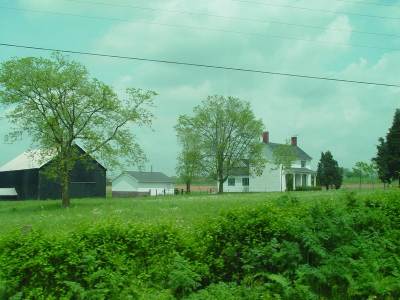
B.W. Stone Home In Georgetown, Kentucky
Now 944 E. Main St. Georgetown
The Stones lived here from 1819 to 1834 when
his family moved to Jacksonville, Illinois
Taken By Judy Smith, 05/2005
Sadly, the home and barn was disassembled in 2023
![]()
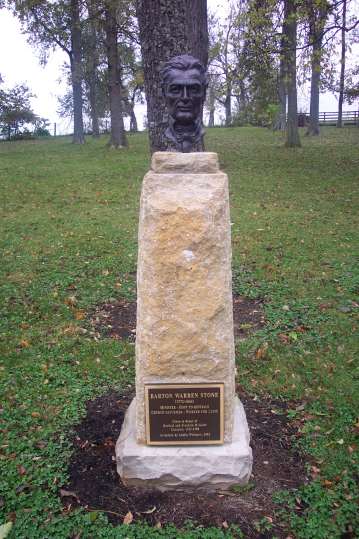
Barton Warren Stone
(1772-1844)
Minister - Host To Revivals
Church Reformer - Worker For Unity
Given In Honor Of
Rachael and Franklin McGuire
Curators, 1985-1998
Sculpture by Adalin Wichman, 2001
![]()
Announcement Of The Death Of B.W. Stone In The Millennial Harbinger

-Jacob Creath, Jr., Millennial Harbinger, Third Series, Vol. 1 #12, December 1844, p.621
![]()
Directions To Cane Ridge & Stone's Final Resting Place
From Lexington: Take I-75 north of Lexington, Kentucky. Take Exit 125 and go east on Hwy 460. When coming into Paris, Hwy. 460 will dead into Hwy. 68. Turn right and then left on Hwy. 460 again. Go a quarter mile and turn left on C0. 537. Go 4 or 5 miles and the Meetinghouse is on the left.
From Paris: Barton W. Stone is buried in the old cemetery at Cane Ridge Meeting House near Paris, Kentucky. Heading north out of Paris on Hwy. 68. After crossing the old Stoner Creek bridge. Turn right on Hwy. 460. Go a few hundred yards and then turn left on Co. Hwy. 537. The meeting house and cemetery will be about five miles out on the left. Head toward the meetinghouse and park in front of the large monuments in the front. You will see Barton Stone's monument as well as others.
GPS Location
38°12'45.1"N 84°07'07.4"W
or D.d. 38.212516, -84.118731
![]()

Buried Here Are The Remains of B.W. & Elizabeth Stone
![]()
THE GRAVE OF BARTON W. STONE
They have made him a grave and his form interred,
'Neath the green and grassy sward;
On the hallowed spot where his voice was heard,
When he pointed the way to the Lord.
It is meet where the banner of Christ he had reared,
And where praise had expended his breath;
Where the church by his presence so often he cheered,
He should slumber—a trophy of death.
The hand of affection has hallowed his home—
While the rock shall above him appear;
The ivy, or grass, that may grow 'round his tomb,
Will be watered with many a tear.
Let him sleep with the dead that have died in the Lord,
For 'tis meet that the laborer rest;
His spirit has gone to obtain its reward,
And now ranges the fields of the blest.
In the list of the greatest, we reckon him great;
How few have attained where he stood,
Tho' many as brilliant in church and in state
Yet who has been equally good?
Sleep on then in quiet, we bid thee farewell!
Till the graves of the saints shall be riven—
Till the good of all ages God's army shall swell;
Farewell! 'til we meet thee in heaven.
By S.W. Irvin, May 15, 1851, Lexington,
Source: The Christian-Evangelist, “The Grave of Barton W. Stone,” by Clayton Keith, October 10, 1901, page 1295.
![]()
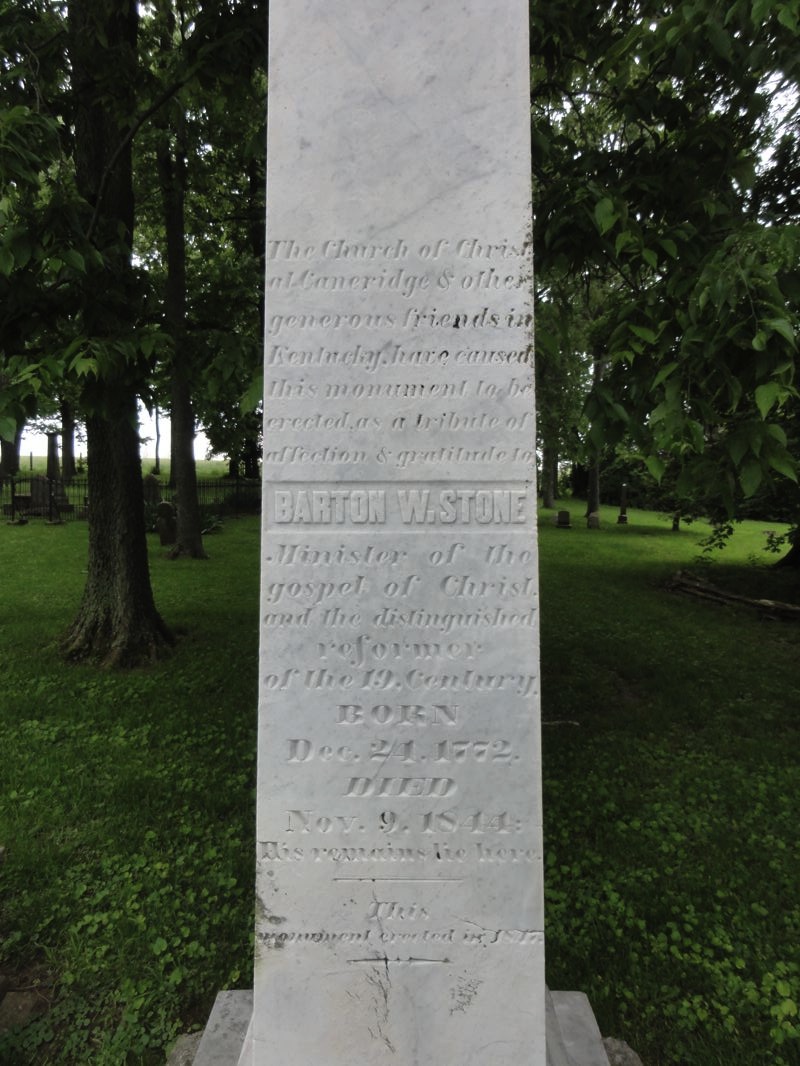
The Church of Christ
at Caneridge & other
generous friends in Kentucky
have caused this monument
to be erected as a tribute of
affection & gratitude to
BARTON W. STONE
Minister of the gospel of
Christ and the distinguished
reformer of the 19 Century.
BORN
Dec. 24, 1772
DIED
Nov. 9, 1844
His remains lie here.
This monument was erected in 1847.
![]()
Read C.C. Ware's Chapter On Stone's Religious Awakening
